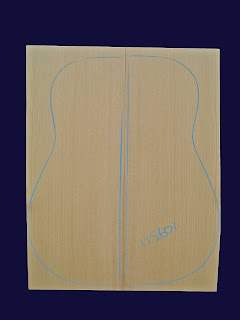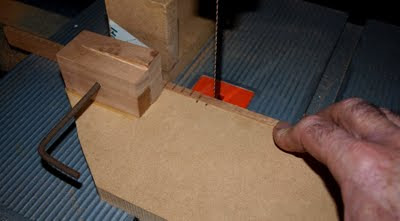Once the kerfed linings are glued to the sides, the sandpaper-lined concave dishes I made use of when shaping and gluing the top and back braces serve their other purpose by helping me sand a drop-off onto the edges of the rim assembly to match the curvature of the back and top plates.
 I can then use a Dremel rotary tool to rout pockets into the linings to accommodate the brace ends. Using the more traditional kerfed linings whose saw kerfs face into the guitar body, there's always a danger that if one or both edges of a brace pocket happen to be in close proximity to the kerfs, a chunk of wood will be dislodged as the pocket is cut. With reverse-kerfed linings, however, the individual sections of wood between the kerfs are firmly glued to the sides and serious chipping of the exposed face of the lining on either side of the brace pocket is far less likely, provided some simple precautions are taken.
I can then use a Dremel rotary tool to rout pockets into the linings to accommodate the brace ends. Using the more traditional kerfed linings whose saw kerfs face into the guitar body, there's always a danger that if one or both edges of a brace pocket happen to be in close proximity to the kerfs, a chunk of wood will be dislodged as the pocket is cut. With reverse-kerfed linings, however, the individual sections of wood between the kerfs are firmly glued to the sides and serious chipping of the exposed face of the lining on either side of the brace pocket is far less likely, provided some simple precautions are taken.When routing the brace pockets, it's important that the Dremel is guided in such a way that the router bit's clockwise rotation doesn't contribute to tearing or chipping of the linings as the pocket is cut. This is particularly important to observe where the left-hand edge of the brace pocket is concerned (i.e., with the guitar side facing me). With that in mind, I make my first cut towards me in the direction of the guitar side along this left-hand margin, easing the router bit into the lining for the equivalent of around half the bit's diameter; a second shallow entry cut on the right-hand side of the pocket defines its width. Several light passes are made from left to right until a single recess is created between the two entry cuts. I repeat this process until the recess extends to the guitar's side and make final adjustments until the end of the brace fits snugly within the pocket. It's difficult to avoid chipping entirely, but by guiding the router in the manner I've described, it's of a minor nature and can be easily cleaned up with sandpaper.
 |  |
 |  |
I rout the pockets in pairs, beginning at the tail-block end of the body. If the first pair of pockets is accurately marked and cut, the centre-line of the back will be correctly aligned from that point on. If a minor adjustment to the back alignment is required, the pockets can be modified accordingly. The second, and subsequent pairs of pockets can then be more accurately positioned, with correct alignment of the back more firmly established as each pair is cut.
Some builders postulate that because reverse-kerfed linings stiffen the rim assembly once attached, there are resultant improvements in the sound of the instrument. Occasionally, it seems, views such as this are repeated often enough by individuals held in high regard within the luthier community that they become accepted as fact, whether or not they've been held up to close scrutiny. I acknowledge that I have a lot to learn and always try to have an open mind when reading of the experiences and opinions of other more experienced builders, but after looking at popular wisdom such as this from all angles, I'm left unconvinced. For what it's worth, my personal view is that while it's somewhat helpful having a stiffer rim to work with in the course of constructing the instrument, from the point at which the back and soundboard are attached to the rims, any contribution the linings may have made to the rims' stiffness is eclipsed by the strength of the top and back in compression. I suspect that in the finished instrument, the linings - reversed or otherwise - play little part beyond their primary purpose: to provide a gluing surface for the top and back plates.
Cheers
Pete
Pete














